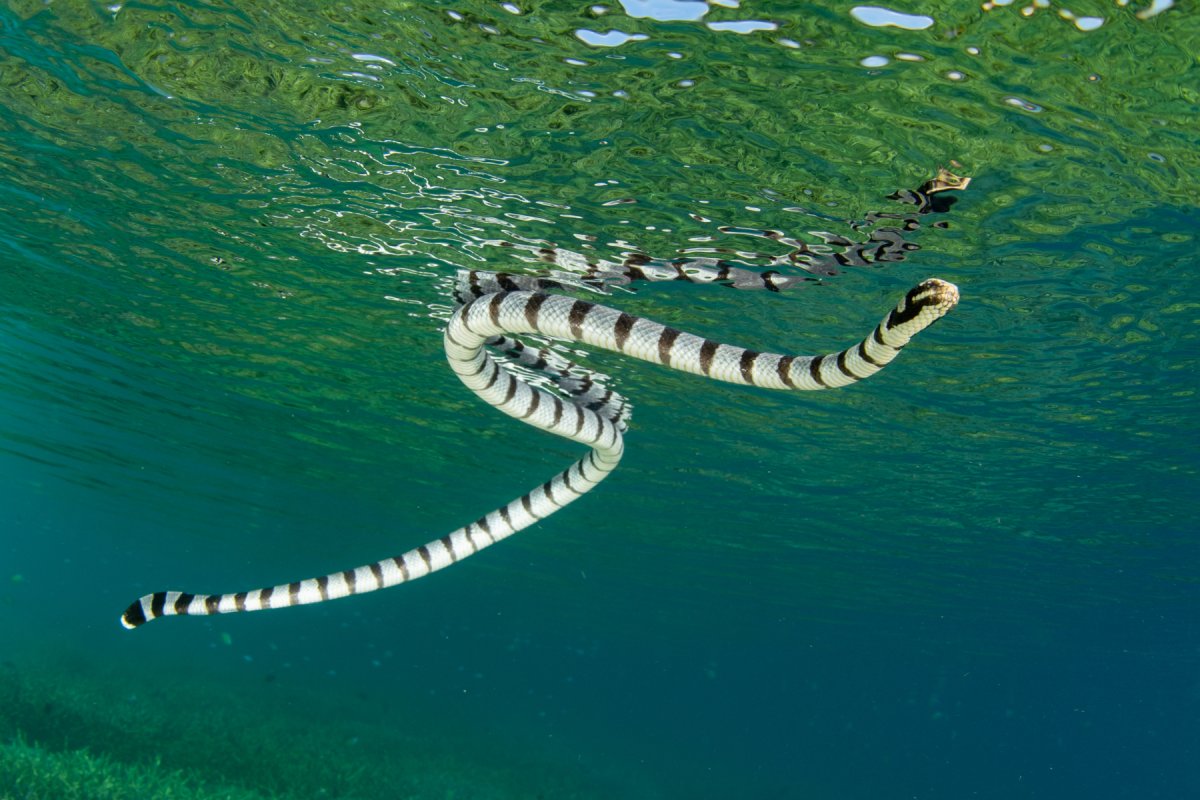Being able to slither gracefully through the ocean isn't the only thing that sets sea snakes apart from snakes on land: Their sex lives are vastly different too.
To adapt to life in the ocean, sea snakes underwent a range of strange adaptations, including changes in size and increased dimorphism—or different characteristics—between the sexes, according to a new paper in the journal Royal Society Open Science.
The paper reveals that female aipysurine sea snakes became increasingly larger than their male counterparts and that males began to develop larger eyes than females to find a mate.
"Males had larger eyes, compared to head length, in all six species. It was statistically significant in three of those species. One reason for larger eyes in males may be that they have shifted to vision to find mates, because (unlike land snakes), they can't follow a scent trail laid onto the ground by a female as she moves along," study author Richard Shine, a professor of biology at Australia's Macquarie University, told Newsweek.

The researchers also found that while males were evolving to be smaller than females, their eyes were getting much larger in comparison to the rest of their bodies. The theory is that this happened to help the male snakes spot the females after their transition to the ocean, as the watery environment makes it impossible to follow a scent trail, which would have happened on land.
"Sexual selection on mate-finding ability offers a plausible selective advantage for larger relative eye size in males," the authors wrote in the paper.
They went on: "Unlike their terrestrial counterparts, male sea snakes cannot locate reproductive females by following substrate-deposited pheromonal trails; and instead, may rely upon visual cues to find mates until the other snake is close enough for chemosensory sampling. The resulting difficulty in finding mates may have imposed strong selection on visual acuity in male sea snakes."
Alternative theories include the possibility that the eyes of the smaller males were simply too small to properly see, leading to them evolving disproportionally larger eyes. Or that the eye size may have originated from the males' and females' differing foraging habits.
As for why the females became larger, the researchers suggest the female may have evolved as such for several reasons, one of which includes the idea of niche partitioning, where the female evolved to eat different prey to avoid competition with the males. This is consistent with observations that many sea snake males and females have sex-based differences in prey type and feeding seasons.
Other suggestions in the paper include the idea that females evolved larger to have more babies or perhaps because of the loss of male-male fighting for females. In species where males fight to compete for access to females, being larger usually gives a male a large advantage: If this behavior is lost, there is no evolutionary pressure driving males to get bigger and bigger.
"Indeed, male-male combat does not appear to have been recorded in any highly aquatic snakes, perhaps because tactics such as pushing a rival's head into the substrate do not work in a three-dimensional aquatic arena," the authors wrote in the paper.
They went on: "The apparent ubiquity of female-larger size dimorphism in sea snakes thus may reflect an evolutionary loss of male-male combat, reducing the benefit to larger body size in males."
The authors hope these findings reveal some of the secrets of how males and females evolve as a result of a transition in habitat from the land to the sea.
"Multiple invasions of marine habitats by snakes offer an especially exciting model system in which to explore the evolutionary mechanisms by which organisms adapt to novel challenges, and the differential consequences of profound habitat shifts for males and females within a species," the authors wrote.
"Repeated evolutionary transitions from terrestrial to aquatic life in snakes provide a powerful opportunity to explore selective forces on sexually dimorphic traits," they said.

A second new paper, also published in Royal Society Open Science, found that sea snakes have evolved to hatch fewer but larger offspring. Both pieces of research were headed by Shine.
The authors suggest that this may be an adaptation to prevent the baby snakes from being picked off by predators, especially fish. After recording predation rates on the baby snakes, the authors found that smaller snakes were more prone to being attacked when going up for air.
"Nobody knows for sure, but my guess is that small snakes are vulnerable to large predatory fish—especially when a snake has to swim up to the surface to take a breath of air. On land, a small snake can remain hidden away and safe—but that option isn't available for sea snakes," Shine said.
Clearly, moving from living on land to swimming around in the sea led to several unexpected changes and adaptations in sea snakes.
Do you have a tip on a science story that Newsweek should be covering? Do you have a question about evolution? Let us know via science@newsweek.com.
Update 12/13/23, 11:49 p.m. ET: This article was updated with comment from Shine.
Uncommon Knowledge
Newsweek is committed to challenging conventional wisdom and finding connections in the search for common ground.
Newsweek is committed to challenging conventional wisdom and finding connections in the search for common ground.
About the writer
Jess Thomson is a Newsweek Science Reporter based in London UK. Her focus is reporting on science, technology and healthcare. ... Read more
To read how Newsweek uses AI as a newsroom tool, Click here.






